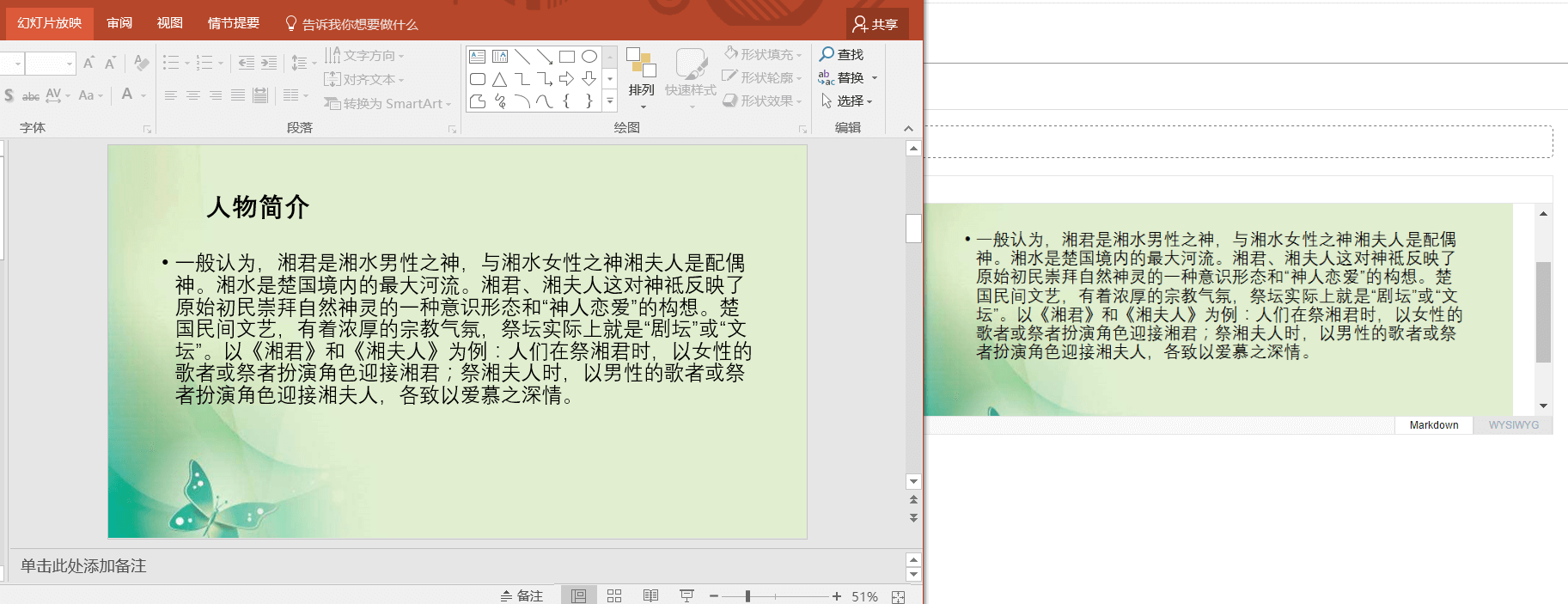每天推薦一個 GitHub 優質開源項目和一篇精選英文科技或編程文章原文,歡迎關注開源日報。交流QQ群:202790710;電報群 https://t.me/OpeningSourceOrg
今日推薦開源項目:《強大的Markdown編輯器tui.editor》
推薦理由:Markdown 是一種可以使用普通文本編輯器編寫的標記語言,通過簡單的標記語法,它可以使普通文本內容具有一定的格式。它的語法簡潔,便於學習,而且功能比純文本要強,因此廣為流傳。而 tui.editor 就是一個超級好用的 Markdown 編輯器。
![]()
而 tui.editor 作為一款 Markdown 語法的編輯器,有如下一些特性:
- 支持 CommonMark 與 GFM(GitHub Flavored Markdown)兩種標準
- 支持豐富的擴展插件,如顏色選擇器、圖表、UML、表格合併
- 提供了所見即所得與 Markdown 這兩種模式,在編輯過程中可以隨時切換,非常方便。在所見即所得模式下,可以直接從瀏覽器、 Excel、PPT等複製文本,並且保留原來的格式

這裡有一個演示的視頻:https://www.youtube.com/watch?v=45a2xSNyHUA&feature=youtu.be
一些快捷的小竅門
tui.editor中有一些新穎的技巧可以提升用戶編輯時的效率,下面介紹一下這些方便的技巧是如何實現的
複製和粘貼
要說到 tui.editor 中的特點,就不能不談它那可以從瀏覽器等直接複製粘貼的功能。而要探討這個功能,就應該先從複製和粘貼的實現方法說起。

操作系統中一般會有一塊成為剪貼板的區域,這塊區域專門處理複製粘貼。複製文本時會將文本克隆到剪貼板中,粘貼時再將剪貼板的文本克隆出去。但是在實際應用時,比如將文本複製到 word 文檔,並不是單純的複製文本,而是保留了文本的字型大小字體等樣式,類似這樣
這實質上是一種標記語言,但如果是複製到記事本這類不支持字型大小字體的應用中時,由於這類應用無法處理這些樣式,被複制過去的文本將會變回該應用默認的字體字型大小。
回到正題,tui.editor 之所以能夠處理複製於 Excel 工作表和瀏覽器等的文本,正是通過複製這些文本時不同的樣式對它們進行相應的處理,從而達到了更加方便快捷的效果。這種效果讓我們在從之前已有的基礎上開始工作時變得更輕鬆。
同步滾動
tui.editor 還有一點很方便的就是當使用 Markdown 模式時,左右兩個窗口可以實現同步滾動,這一點其實可以由 JavaScript 來實現。
- 確定左右兩個容器元素
- 監視滑鼠進入某個滾動容器元素的事件,當這個事件發生時,處理進入的容器元素滾動事件的同時,將其 scrollTop 值賦給另一個容器元素(如果直接在其中一個元素觸發滾動事件時把它的 scrollTop 值賦給另一個元素,就會造成循環觸發的情況,滾動會減緩)
如果需要適應更複雜一點的狀況,例如說左右兩個元素內容高度不同時的情況,只需要確定它們兩個元素的 scrollTop 之間的比例,然後對上述方法修改即可,基本上還是使用這個方法來實現同步滾動的效果。
相關鏈接
如果你還想更多的了解這款編輯器,可以去它的 GitHub 頁面上看一看:
https://github.com/nhnent/tui.editor
或者直接去試用一下這款編輯器:https://nhnent.github.io/tui.editor/api/latest/tutorial-example00-demo.html
今日推薦英文原文:《Submitting my first patch to the Linux kernel》作者:
原文鏈接:https://opensource.com/article/18/4/submitting-my-first-patch-linux-kernel
推薦理由:說真的,在喜歡 Linux 的朋友心中,能向 Linux Kernel 提交代碼可真的是一件至高無上的榮譽,這篇文章就是講述作者的這個經歷,來一起看看怎麼做到的吧。
Submitting my first patch to the Linux kernel

I started using Linux three years ago while attending university, and I was fascinated to discover a different desktop environment. My professor introduced me to the Ubuntu operating system, and I decided to dual-boot it along with Windows on my laptop the same day.
Within three months, I had completely abandoned Windows and shifted to Fedora after hearing about the RPM Package Manager. I also tried running Debian for stability, but in early 2017 I realized Arch Linux suits all my needs for cutting-edge packages. Now I use it along with the KDE desktop and can customize it according to my needs.
I have always been intrigued by Linux hacks and the terminal instead of using ready-made unified installers. This led me to explore the Linux kernel tree and find a way to contribute to the community.Submitting my first patch to the Linux kernel was a breathtaking experience. I started the second week of February 2018, and it took me about an hour to clone the latest Linux kernel source tree on an 8-Mbps internet connection, and nearly all night to compile and build the 4.15 Arch Linux kernel. I followed the KernelNewbies guide and read the first three chapters of Linux Device Drivers, Third Edition. This book introduced me to the device drivers, along with the specific types, and described how to insert/remove them as a module during the runtime. The sample code in the book helped me create a hello world driver and experiment with the insmod and rmmod commands (the code samples in subsequent chapters are a bit outdated).
Many people advised me to read books on operating systems and Linux kernel development before contributing; others suggested following the KernelNewbies』 guide and using the bug-finding tools to fix errors. I followed the latter advice because I found exploring and experimenting with the code around errors is the best way to learn and understand the kernel code.
My first cleanup was removing the "out of memory" warning by running the checkpatch.pl script on the vt6656 driver directory. After adding the changelog and updating the patch, I submitted my first patch on February 10. After I added the changelog, I received an email from Greg Kroah-Hartman on February 12, stating that my patch had been added to the staging-next branch and would be ready to merge in the next major kernel release.
I recommend keeping your first patch simple; one or two lines will inspire you to contribute more. Keep in mind that quality, not quantity, is what matters. Before contributing to the TODO list of the drivers, you should acquire extensive knowledge of device drivers and the operating system. The thrill of contributing will keep you going.
每天推薦一個 GitHub 優質開源項目和一篇精選英文科技或編程文章原文,歡迎關注開源日報。交流QQ群:202790710;電報群 https://t.me/OpeningSourceOrg
